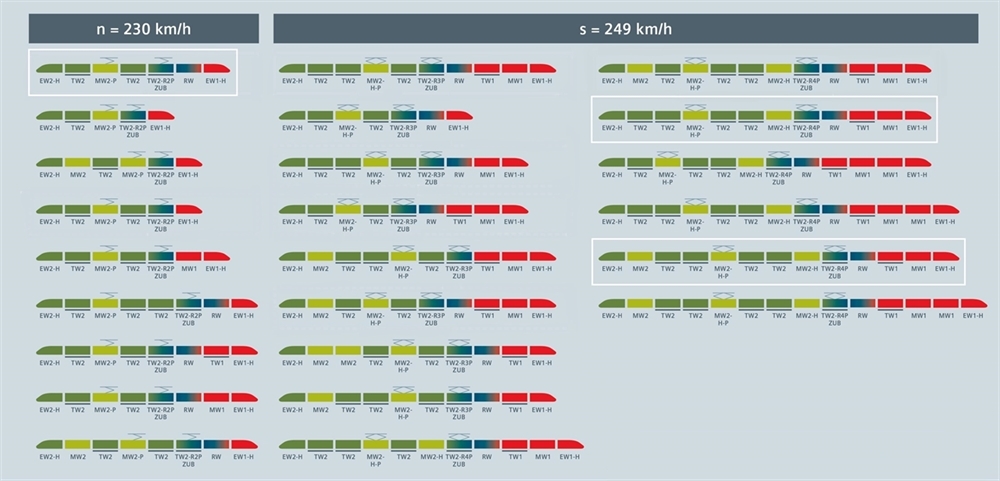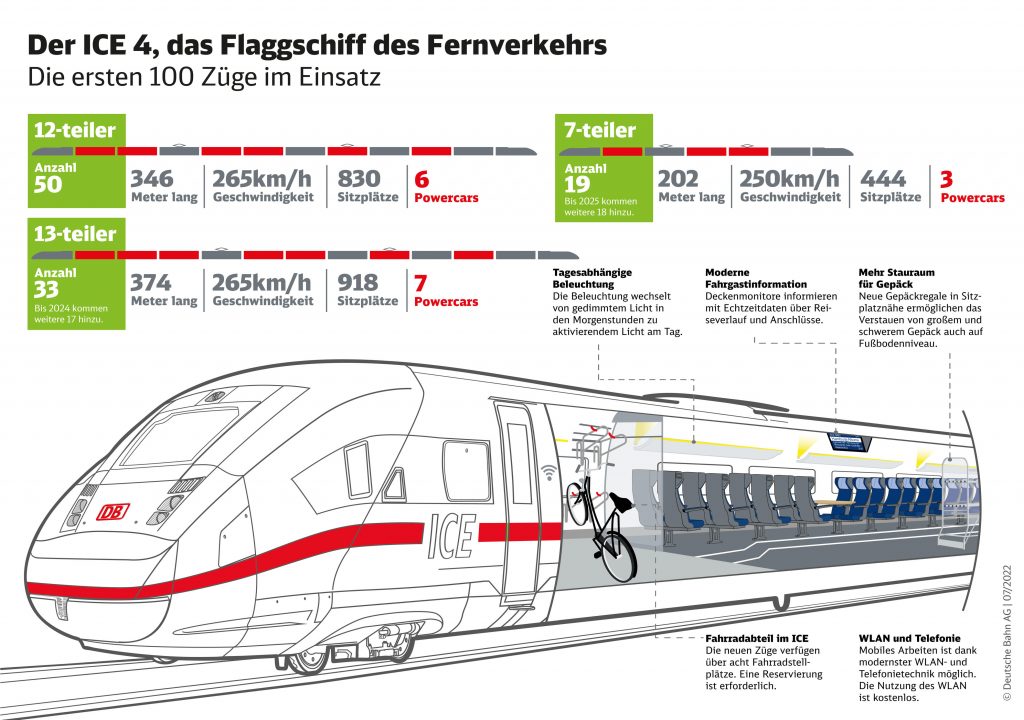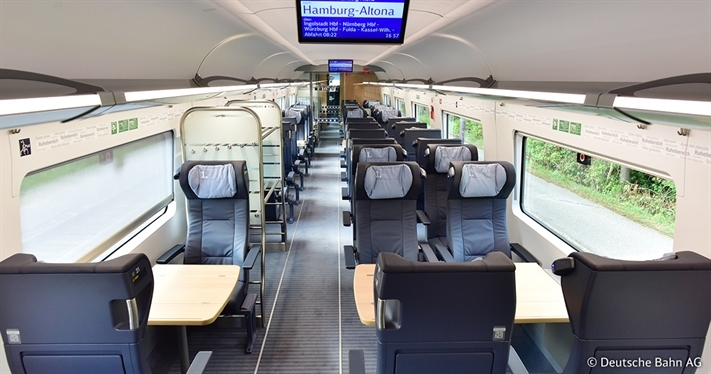Rolling stock • Block train • High speed train • Germany • DB Fernverkehr • ICE 4 Siemens
➤ See also: AGV ETR 575 – Avelia Horizon
Note: For educational purpose only. This page is meant purely as a documentation tool and has no legal effect. It is not a substitute for the official page of the operating company, manufacturer or official institutions. It cannot be used for staff training, which is the responsibility of approved institutions and companies.
In brief
Deutsche Bahn (DB) and Siemens signed a framework agreement for 300 new long-distance trains in May 2011, initially in seven-car and twelve-car configurations. But the project actually dates back much further.
In 1996, when studies for the ICE 3 were underway, a project managed by German industry in coordination with Deutsche Bahn was already planning to anticipate a further increase in long-distance passenger traffic. The key aim is to increase train capacity against a backdrop of shrinking train paths on the DB Netz network. Variants of 456-seat or high-density ICEs were presented, including a study of an ICE 40cm wider, which was quickly rejected. As DB released its ICE 2 and ICE 3, none of these variants were retained. Deutsche Bahn itself also wanted to anticipate the end of Intercity trains, some of whose cars were almost 40 years old. The aim was to replace vehicles built between 1971 and 1990, including the ICE 1s, which will be extended until 2030.
In 2008, these findings gave rise to the ICx project, which was officially presented in January 2010.
Siemens won a framework contract to supply 300 ICx units. Deliveries were planned in three phases:
• 130 trainsets in the first phase by 2016;
• 90 trainsets in a second phase and
• 80 in a third and final phase.
But things turned out to be more complicated. Over recent years, ICE 4 orders changed in length and quantity. Deutsche Bahn showcased an ICE 4 end car model at InnoTrans 2012. Plans for multi-system use abroad were dropped in 2013. DB pursued shorter intercity trains via IC2s and later acquired WESTbahn’s KISS fleet in 2019, influencing overall high-speed trainset requirements and future deployment strategy.
Family name: ICE
Class: 7-cars trainset: 9201 – 9237
xxxxxx12-cars transet: 9001 – 9050
xxxxxx13-cars trainset: 9451 – 9500
Manufacturer(s): 70% Siemens, 30% Bombardier
Train type: Trainsets
Sector: Passengers transport
Type of service: Main line
Operator(s): DB Fernverkehr
First services: 2016
————————
Train length: 7-cars trainset: 202m
xxxxxxxxxxxx12-cars transet: 346m
xxxxxxxxxxxx13-cars trainset: 374m
Maximum speed: 265 km/h
Traction system: Siemens SIBAS PN IGBT–VVVF
Electric system(s): 15 kV 16.7 Hz AC
Power car(s): 7-cars trainset: 3 power cars
xxxxxxxxxxxx12-cars transet: 6 power cars
xxxxxxxxxxxx13-cars trainset: 7 power cars
Pantograph:, 2 to 4 per power car
Braking system(s):
Track gauge: 1,435 mm
————————
Formation: see details bellow
Seats first class: see details bellow
Seat second class: see details bellow
Restaurant car: yes
Bar car: yes
Total seats: see details bellow
The definition of a high-speed train varies by region, but generally, it refers to trains that operate at speeds of at least 250 km/h (155 mph) on newly built lines and 200 km/h (124 mph) on upgraded lines. In Europe, for example, the UIC (International Union of Railways) considers a commercial speed of 250 km/h as the principal criterion for high-speed rail. In the United States, the definition can include trains operating at speeds ranging from 180 km/h (110 mph) to 240 km/h (150 mph).
➤ See the UIC definition
In addition, the european’s TSI gives two high-speed classes (according 2008/232/EC point 4.2.1.1 b) :
• Class 1: trains with a maximum speed of 250 km/h or more;
• Class 2: trains with a maximal speed of at least 190 km/h, but less than 250 km/h.
Modular design
With the ICE 4 high-speed train, Siemens has introduced a new, flexible concept for Deutsche Bahn: all the carriages are built as independent, autonomous units. Depending on requirements, between five and fourteen cars can be assembled to form a trainset. Siemens has planned five types of vehicle to be assembled:

(on the left the second class, on the right the first)
• Driver cars
• Power cars without pantograph
• cars with or without pantograph
• restaurant car
• service power car with pantograph and signalling protection ZUB
Ce système modulaire permet alors en théorie d’obtenir 24 combinaisons au choix :

The choices of DB Fernverkehr
Over the last few years, the ICE 4 orders have been modified several times, with more trains and different lengths. At InnoTrans 2012, Deutsche Bahn presented for the first time a 1/1 model of an ICE 4 end car section on its stand. In 2013, the option of multi-system equipment to operate abroad, and more specifically in the Netherlands, was abandoned in order to focus solely on the 15kV zone, i.e. Germany, Switzerland and Austria.
There will be three changes over the years, and it’s best to stick to the number of cars:
• in 2011, 130 trainsets were planned, with a total of 1,165 cars;
• in 2013, 130 trainsets were still planned, but some of them were longer, with a total of 1,335 cars;
• in 2017, 119 trainsets were planned, but with an unchanged total of 1,335 cars.
In the meantime, DB wanted to expand its range of short intercity trains. This led to a framework agreement in 2008 with Bombardier to supply three batches of intercity trains called IC2s, which have nothing to do with high-speed, since they are Twidexx double-decker trains pulled by TRAXX AC3 locomotives. In 2019, the private Austrian operator WESTbahn preferred to dispose of its fleet of 17 KISS trainsets in order to renegotiate financing conditions with Stadler. DB has acquired this young fleet, as part of an intercity deployment yet to be defined. This whole strategy has influenced the number of trainsets needed for high speed.
Coming back to the ICE 4, if we stick to the September 2018 figures, we can summarise the order as follows:
• 37 trainsets of 7 cars numbered 9201 to 9237;
• 50 trainsets of 12 cars numbered 9001 to 9050, instead of 100 trainsets, because DB divided the order to obtain…
• 50 trainsets of 13 cars numbered 9451 to 9499 (subject to change), in order to increase the number of seats.
The basic principle is the construction of five technically unified vehicles, which are assembled to form trainsets of variable length, like a sort of Lego. The provisional count for 2020 was 137 trainsets totalling 1,511 cars (including 2 in reserve). The basic characteristics are as follows:
7-cars trainset – 9201 to 9237
The introduction of the seven-car short ICE 4s has been considerably delayed, with the first order dating back to 2011, following several contract changes as mentioned above. A short six-car trainset, without a Bistrot vehicle, was being tested by DB Systemtechnik during 2019. It is planned to use them for 2020 on the Cologne/Ruhr-Berlin and Frankfurt-Stuttgart-Munich-Vienna routes.
Class : 9201 – 9237
Electric system(s): 15kV 16 ²/³Hz
Traction motors: 12
Power output: 4.950kW
Maximal speed: 250km/h
Weight in service : 469T (normal) – 513T (max)
Lenght : 202m
Seats: 465 seats in second class
xxxxxxx77 seats in first class
First service: 2017
12-cars trainset – 9001 to 9050
The twelve-car ICE 4 trainset was approved and authorised to operate on the German network by the EBA on 16 September 2016. For the December 2017 timetable, DB put it into service on the Hamburg – Munich and Hamburg – Stuttgart routes, after more than a year of intensive testing. In the December 2019 timetable, ICE 4s will reach Switzerland on the Hamburg – Frankfurt/Main – Karlsruhe – Basel – Zurich – Chur route, and since June 2020 these trains have also been running on the Berlin – Frankfurt/Main – Karlsruhe – Basel – Bern – Interlaken route.
Class : 9001 – 9050
Electric system(s): 15kV 16 ²/³Hz
Traction motors: 24
Power output: 9.900kW
Maximal speed: 265km/h
Weight in service : 818T (normal) – 893T (max)
Lenght : 345,73m
Seats: 625 seats in second class
xxxxxxx205 seats in first class
First service: 2016
13-cars trainset – 9451 to 9500
The thirteen-car ICE 4 trainset is the result of yet another change of order: instead of 100 12-car trainsets, half were converted into 13-car trainsets, adding another 50 vehicles to be supplied. Such a trainset was being tested in 2019. Interestingly, in order to “stick” to the full service interval planned for the future, known as Deutsche Takt, the 13th motorised car would enable the maximum speed to be increased to 265km/h. Note that the number of first-class seats remains the same in both the 12-car and 13-car versions.
Class : 9451 – 9500
Electric system(s): 15kV 16 ²/³Hz
Traction motors: 28
Power output: 4.950kW
Maximal speed: 250km/h
Weight in service : 892T (normal) – 923T (max)
Lenght : 373m
Seats: 713 seats in second class
xxxxxxx205 seats in first class
First service: 2021
Technical specifications

Technical specifications for interoperability
The TSIs applicable to high and very high speed rolling stock are currently the LOC & PAS TSI (locomotive and passenger vehicle rolling stock), the PMR TSI (persons with reduced mobility) and the SRT TSI (safety in rail tunnels). The TSI offers two high-speed classes (according 2008/232/EC point 4.2.1.1 b) :
• Class 1: trains with a maximum speed of 250 km/h or more;
• Class 2: trains with a maximal speed of at least 190 km/h, but less than 250 km/h.
In addition, there is also a specification of dynamic wheel load as a function of speed, where the 250km/h limit is also included. When the orders were originally placed, the ICE 4s complied with Class II TSIs, as they were initially limited to 230 and 249km/h. However, in March 2013, Deutsche Bahn’s Supervisory Board decided to increase the speed of the 13-car trainsets to 250km/h for 12-car trainsets and 265km/h for 13-car trainsets, thereby switching the requirements to Class 1.
Seat density
The Germans never accepted the French design of the double-decker high-speed train. The ICE 4 concept, which had to accommodate very dense operations under the interval timetable, therefore had to find the most suitable formula for carrying a maximum number of passengers, while allowing a large number of passengers to come and go.
So we played with length. The good UIC standard universal 26.40m car is a thing of the past: on the ICE 4, the cars are between 28.75 and 29.10m long. The train’s available floor space means that 918 seats can be squeezed into the 375m of the thirteen-car version, giving a passenger density of 2.45 per metre. If we take a 375m train:
• we would have needed 14 standard UIC 26.40m cars, i.e. 56 axles that would wear out the track;
• with 13 cars, we save one car, 4 axles, 4 doors as well as 2 toilets and 2 intercirculations, etc. These details resulted in 5 extra rows of seats for the same length.
To achieve the density of 2.5 passengers per metre, Siemens built a 1:1 scale model. According to the original plans, the first-class carriages were to have 52 seats, whereas extending the length of the carriages made it possible to insert 100 seats in second class, regardless of the type of vehicle (motorised or non-motorised). This overly dense layout was criticised from the outset by Deutsche Bahn’s Supervisory Board and the Passenger Advisory Council. Changes to the pitch between seats and the addition of extra luggage racks reduced the capacity of the intermediate second-class carriages to 88 seats instead of the planned 100, while the intermediate first-class carriages took 67 seats.
The first/second class ratio remains below 25%:
• 7-car trains: 465 second-class seats, 77 first-class seats, i.e. 14%;
• 12-car trains: 625 second-class seats, 205 first-class seats, i.e. 24.7%;
• 13-car trains: 713 second-class seats, 205 first-class seats, i.e. 22.3%.
In the end, we obtain the following diagram for the 12-car train:




🟧
←
→
[TOP]
Rolling stock • Block train • High speed train • Germany • DB Fernverkehr • Lexical
